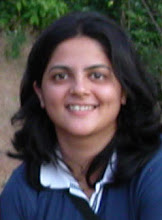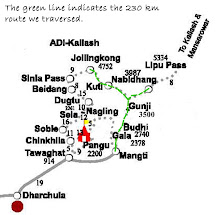It was a crisp, cool morning when we started our much awaited journey. 9 of us (all of us are first or second cousins, and live in the same city) flew from Pune to Delhi on SpiceJet flight SG-204. Since the bookings were done almost 2 months in advance, we got good deals on round trip tickets. 2 other friends would fly from Mumbai to join us at Delhi.
I'd tried to reduce my luggage as much as possible. I still ended up with a haversack that weighed a ton and wore six-pocket cargoes with all six pockets bulging. I didn't want to go to the hassle of a cabin bag, so I stuffed a few necessities in my pockets. Little did I know I was just inviting trouble.
At the baggage check, I suddenly had a premonition. As my sack went into the scanner, I thought, They're going to ask me to open my sack. Because I had about 1 kg of Glucon-D packed in a ziplock, and it was surely going to look like heroin or cocaine on x-ray. Oh God! And sure enough, the official called out, "Whose bag is this?" Oh, the blue and black haversack? Well sir, that's mine. "Could you open it, please?" Sure, I love packing and unpacking and repacking.
I asked him anyway, "Is there a problem with my bag?" He called me to the scanner and asked me "What's this?" I turned to look, fully expecting my bag of heroin, I mean Glucon-D, to be displayed. Instead he showed me a weird shape like a bottle with a nozzle. Huh? "Is that hairspray?" Hairspray?On a trek? My cosmetics were tooth paste, tooth brush, bath soap, sunscreen and lip balm. Period. No, no, that wasn't hair spray. He then looked at me a little closely and asked, "Are you carrying vodka, ma'm?" Vodka! Me, a poor teetotaler! I racked my brains , but just couldn't remember packing anything that looked like that.
Then he asked a magic question, "Is that an oxygen cylinder?" Eureka! It was indeed an oxygen cylinder. With 2 senior members in the team and the trek reaching altitudes close to 5000m, it seemed prudent to carry an oxygen cylinder as precaution. Being an orthopaedic surgeon, my husband had procured one and packed it in my sack.
To cut a long story short, it was left behind at the Pune airport. It is pressurized oxygen, and not safe to carry on board a plane. Lesson 1: If you need to carry an oxygen canister, pick it up later in Delhi.
At the security check, everybody cleared the gates quickly. I entered the enclosure and didn't emerge for about 3 mins. My cousins gathered at the other end. Where has she gone? Well, I was asked to empty every single one of those bulging six pockets, and each item was scrutinized carefully. Lesson 2: It is better to carry a few items in a small bag rather than stuffing them in your pockets to keep your hands free.
The rest of the journey was uneventful and we reached Delhi at about 10:30 AM. In the evening we would catch the Ranikhet Express to Kathgodam in Uttaranchal.
Friday, October 26, 2007
28th July - Pune to Delhi.
Posted by Asawari Badve at 2:52 PM 0 comments
Monday, October 22, 2007
Now the Good Stuff - Foodstuff
All treks on the route of Adi Kailash and Om Parbat have to go through the KMVN. The various camps that we stayed at provided decent meals. The basic 3 meals - breakfast, lunch and dinner - were more than adequate. We never had to cook anything. So there was no need to carry any cooking utensils, gas stoves, etc.
However, the basic three meals are not enough all the time. Sometimes, you get hungry while walking. Or you are just plain tired and need an energy boost. The whole group divided up the dry snacks and each one brought the items assigned to him/her in a large quantity to share with everyone. On a long, strenuous trek that tests the limits of your endurance, 'sharing' is a very important word.
Between the 11 of us, we carried the following foodstuff.
1. Riceflakes Chivda
2. Peanut and jaggery laddoos
3. Peanut Chikki
4. Dryfruit laddoos
5. Shankarpali (a Maharashtrian sweet made out of wheat flour, ghee and sugar)
6. Amla Candy
7. Flavoured sugar candy
8. Gulpoli (Sweet Parathas stuffed with a mixture of jaggery, peanut and sesame powder flavoured with nutmeg. another Maharashtrian speciality. Yummy! but more importantly, high calorie.)
Each one also brought their own stock of dry fruits to munch on. The climate in the himalayas is such that you need a lot of energy to stay warm and to keep walking constantly. The best combination is a mixture of cashews, dried figs and walnuts. Keeps you pepped up throughout the day. Candied sweets keep the throat from getting parched and conserve the limited water you can carry throughout the day.
Posted by Asawari Badve at 8:22 AM 0 comments
Saturday, October 20, 2007
Clothes and Gear For The Trek
This trek is most commonly described as 'hazardous'. The first thing to do is to take it completely seriously and pack carefully.
As the route is at a high altitude, 12000 - 14000 feet, there are cold winds, especially at night. The weather is unpredictable. Bright sunshine can quickly turn into torrential downpour. Therefore the clothing needs to be light, wind-proof and warm. Here's a list of the bare minimum gear we packed.
1. Wind-proof jacket (preferably with hood) 1 no.
2. Light cotton jacket which can double up as a suncoat 1 no.
2. Sweaters 2 full sleeves 1 half sleeve
3. Balaclava (Monkey cap) 1 no.
4. Woollen and leather gloves 1 pair each
5. Woollen socks 2 pairs
6. Cotton socks 10 pairs
7. Long pants 3 nos. (I wore light 6-pocket cargoes. Jeans are useless and cumbersome)
8. Shirts/T-shirts 6-7 nos.
9. Sun glasses (anti glare are preferable), with chain so it can hang around the neck
10. Trekking shoes 2 pairs (carry extra shoe laces).
The shoes are the most important part of the gear. The route is very slippery in places, so a sole with good grip is mandatory. My husband and I both wore trekking shoes from Reebok and they were fabulous. That's not to say other brands wouldn't work, but I can vouch for Reeboks personally.
11. Rubber slippers 1 pair. (To use at the end of the day when you need to air your feet.)
12. Peaked cap or broad brimmed hat 1 no. (for protection against the sun)
13. Water bottle (large) 1 no and (small) 1 no to hang from the waist.
14. Torch light (carry two sets of extra cells and one bulb) 1 no.
15. Raincoat (large size) 1 no. No ponchos, please!
16. Belt pouch for camera/money/ medicines/candy etc 1 no.
17. Large Plastic sheet for water proofing your luggage 1 no.
18. Strong nylon rope to tie luggage on the mule. About 6metres long.
19. Toilet paper
20. Sun screen lotion 1 no. Buy the biggest bottle with the highest SPF factor you can. You can get terribly sunburned out there.
21. Candles
22. Match box/lighter
23. Multipurpose knife 1 no.
24. Haversack (Large) to pack all the gear 1 no. This can be loaded on a mule.
25. Backpack (Small) 1 no. To hold water, some food, etc that you can carry while trekking.
Posted by Asawari Badve at 9:55 PM 0 comments
Wednesday, October 10, 2007
Paperwork Before Grunt Work
The next few months were spent in readying for the trek. Uncle Sudhir was a gem in this regard. He took care of all flight and railway bookings and basically managed the whole trek. His friend Bharat Shah who runs High Adventure, a tourism enterprise based in Almora, Uttaranchal, did the rest. Shahji, as he is fondly called, looked after hotel reservations, transport in Uttaranchal, all the necessary tourist permits and hiking permissions, etc. He coordinated the trek with the Kumaon Mandal Vikas Nigam (KMVN, for short) which is the only resource for camping out in the mountains on the route. He is a highly experienced guide and was our official trekking guide on the route.
Since most of the Adi Kailash route comes under the inner-line area, being on the Indo-Tibet border, the rules are quite stringent. We had to supply copies of valid passports, or character certificates from the chief of our local police station. Since the trek is highly strenuous, a medical certificate from a qualified doctor is a must. Shahji sent us application forms to the DM, requesting permission for entry to the inner-line area. We duly filled them, signed them, attached recent photographs and sent them off. All this was done well before June 2007, since we were supposed to leave on the 28th of July.
With the paperwork almost over, we began training for the trek.
Posted by Asawari Badve at 10:53 AM 0 comments
Thursday, October 4, 2007
The Start of the Adventure
My husband Sushrut and I love to trek. Living in the western state of Maharashtra in India affords us plenty of opportunities to go trekking in the surrounding Sahyadri ranges. But I must confess, I am an amateur, at best. My fitness level is pretty ordinary. I do have better stamina than you would expect from a person who gets as less exercise as I do. But, that has more to do with genetics than anything else.
So here I was, on the 2nd of February, 2007, talking to my Uncle Sudhir, and out of the blue, he asked me, “We are planning to go to Adi Kailash in Uttaranchal, sometime in July-August this year. Would you like to join us?” My husband immediately agreed to go, but I was skeptical. I only knew then that Adi Kailash was a mountain peak somewhere in the Himalayas and that the trek was a strenuous haul of around 150 kms (Ha! It was actually close to 220 kms, but thankfully I only found that out much later).
I didn’t want to miss the opportunity, and yet I was worried about my physical capability and fitness. Finally I decided to throw caution to the wind and go. It would later prove to be the best impulsive decision I’d ever taken.
Posted by Asawari Badve at 1:51 PM 1 comments


